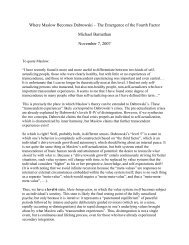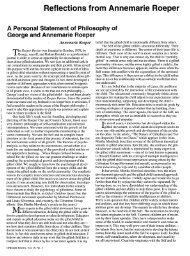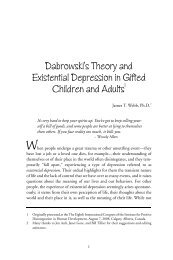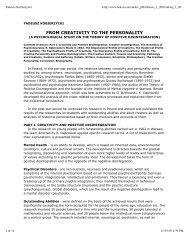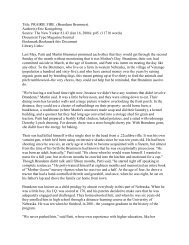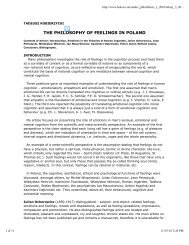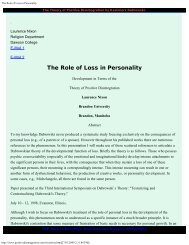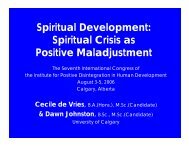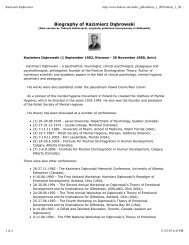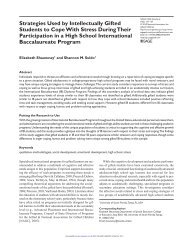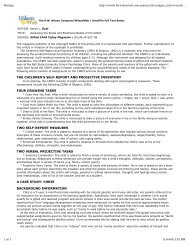Patterns of Overexcitability Overexcitabilities - Kazimierz ...
Patterns of Overexcitability Overexcitabilities - Kazimierz ...
Patterns of Overexcitability Overexcitabilities - Kazimierz ...
Create successful ePaper yourself
Turn your PDF publications into a flip-book with our unique Google optimized e-Paper software.
<strong>Patterns</strong> <strong>of</strong> <strong>Overexcitability</strong><strong>Overexcitabilities</strong>: A New Way to Think About Talent?Downloaded By: [Canadian Research Knowledge Network] At: 21:10 26 March 2011Carol L. TiesoResearchers and educators in the field <strong>of</strong> giftededucation have been tantalized by thepromise that Dabrowski's Theory <strong>of</strong> PositiveDisintegration, with its depiction <strong>of</strong> intensitiesor overexcitabilities (OEs), provides a meansfor identifying gifted students that is differentthan the usual standardized tests. Thus far,most information on OEs has been providedby a questionnaire, which is made up <strong>of</strong> 21open-ended questions. In this study, the<strong>Overexcitability</strong> Questionnaire II (OEQII), a Likert-typesurvey for addressing the OEs, wasused to distinguish between typical and giftedstudents, and various subgroups <strong>of</strong> gifted andtalented students. Results suggest that thereare several differences on the OEQII's fivesubscales: Psychomotor, Intellectual, Imaginational,Sensual, and Emotional OEs for gendergroups, elementary- and middle-school students,and typical and gifted students.Dr. Carol Tieso currently teaches courses ingifted education at The College <strong>of</strong> William andMary. Prior to joining the faculty at The College<strong>of</strong> William and Mary, she served as programcoordinator for gifted programs at the University<strong>of</strong> Alabama. She completed her doctoral workat the University <strong>of</strong> Connecticut and earned herPhD in Educational Psychology with anemphasis on Gifted and Talented Education.Dr. Tieso's current research interests includeexamining the impact <strong>of</strong> flexible grouping andcurriculum differentiation models on students'achievement and investigating patterns <strong>of</strong>Dabrowski's <strong>Overexcitabilities</strong> in gifted, talented,and creative students. Her teaching interestsfocus on meeting the socioemotional needs <strong>of</strong>talented students and increasing the enrollment<strong>of</strong> culturally, linguistically diverse students ingifted programs. E-mail: clties@wm.eduBackground <strong>of</strong> the StudyThe age-old debate over nature vs.nurture has captured the interest <strong>of</strong> manyresearchers and educators in the field <strong>of</strong>gifted education. Intelligence, creativity,giftedness, and the heritability <strong>of</strong> thesecharacteristics has inspired debate andinquiry for a century and a half, and sulliedthe definition and identification <strong>of</strong>giftedness. Perhaps the most overlookedand underappreciated aspect <strong>of</strong> this232/Roeper Review, Vol. 29, No. 4debate lies in the affective domain.Hollingworth (1929) was among the firstresearchers to recognize and address anaffective component in giftedness.Dabrowski (1964), through his work withgenius and depravity during the rise <strong>of</strong>Fascism in Europe, identified five specialkinds <strong>of</strong> intensities or characteristics thatseemed to help determine to what level<strong>of</strong> moral development one would ascend.The characteristics recognized were psychomotor,intellectual, imaginational,sensual, and emotional OEs. The concept<strong>of</strong> Psychic <strong>Overexcitabilities</strong> grew out <strong>of</strong>Dabrowski's original concept <strong>of</strong> developmentpotential—a theory that evolvedfrom his work with gifted individualsunder conditions <strong>of</strong> extreme stress. Morespecifically, his theory comes from therise <strong>of</strong> extremism between the first twoWorld Wars and his rejection <strong>of</strong> theFreudian view that adult neuroses werebrought on by childhood trauma.Developmental Potential and the<strong>Overexcitabilities</strong>Developmental potential (DP) isdefined as a genetic endowment <strong>of</strong> traitswhich determine what level <strong>of</strong> moraldevelopment a person may reach underoptimal conditions. Rather than discussingthe "norm" <strong>of</strong> human behavior,Dabrowski was interested in studying theextremes <strong>of</strong> human personality; hefocused his research on eminent, gifted,and creative individuals. He theorizedthat during times <strong>of</strong> great stress or crisis,individuals highest in emotional intensity,would suffer a more pronounced kind<strong>of</strong> pain than those <strong>of</strong> normal temperament.He further suggested that this painwould lead to a "positive disintegration"<strong>of</strong> one's current developmental level toascend to a higher level <strong>of</strong> moral functioning.Those with the most intense feelings(e.g., feelings <strong>of</strong> differentness orinadequacy, inner conflict, or shame andguilt) could reach the highest level <strong>of</strong>development. The defining characteristics<strong>of</strong> DP are five forms <strong>of</strong> overexcitabilityand special talents and abilities. The fiveforms <strong>of</strong> psychic overexcitability weredescribed by Dabrowski (1938) prior tothe formulation <strong>of</strong> his theory <strong>of</strong> positivedisintegration; they were described as"types <strong>of</strong> increased psychic excitability"and were introduced to denote a variety<strong>of</strong> types <strong>of</strong> nervousness he had witnessedin gifted and creative individuals (as citedin Piechowski, 1999). Nervousness istension in the nervous system, andDabrowski got the idea for describing theforms <strong>of</strong> overexcitability from his observations<strong>of</strong> children under tense situationsin school. He noted that in the early part<strong>of</strong> the century, children had to stand upsilently and respectfully when the teacherentered the classroom. But in that tenseand silent atmosphere, some studentssquirmed restlessly in their seats; somewere quiet but not paying a bit <strong>of</strong> attention;some sat upright and tense withtheir eyes closed; a few looked alert andexpectant. Dabrowski interpreted this inthe following way: the imposition <strong>of</strong>restraint provokes emotional tension, andthis tension finds expression in severaldifferent modalities. Children that squirmin their seats release their tension psychomotorically;the daydreamers escapetheir tension through the world <strong>of</strong> fantasyor spontaneously create pictures andscenes as images <strong>of</strong> the sources <strong>of</strong> tension;the upright, tensed children feel thestress emotionally; and the alert ones gettheir minds going and are ready to puttheir wits to use. Dabrowski hypothesizedthat these characteristics <strong>of</strong> overexcitabilitywere more prevalent in giftedindividuals than in the general population,and he suggested that they may leadto higher levels <strong>of</strong> moral development ingifted individuals.Silverman (1993) suggested thatthese intensities, <strong>of</strong>ten manifestedby gifted and talented (GT) studentsand adults, may be expressed in displays<strong>of</strong> intense energy, enthusiasm, absorptionin their chosen pursuits, vivid imagination,and strong sensual reactions tostimuli; but the gifted are also known tobe emotionally vulnerable (Hollingworth,1942; Silverman, 1994). Theytend to react strongly to aesthetic, intellectual,emotional, sexual, and otherstimuli. According to Piechowski (1999),"overexcitabilities feed, enrich, empower,and amplify talent" (p. 325). The termManuscript submitted October 5, 2005.Revision accepted August 22, 2006.Roeper ReviewSpring 2007, Vol. 29, No. 4, 232-239.
Downloaded By: [Canadian Research Knowledge Network] At: 21:10 26 March 2011overexcitability, rather than justexcitability, was chosen to convey theidea that this is a special kind <strong>of</strong>excitability, one that is enhanced and distinguishedby characteristic forms <strong>of</strong>expression. Dabrowski's theory hasengaged theorists, researchers, and educatorsin the field <strong>of</strong> gifted education formany years. Researchers, intrigued bythe blending <strong>of</strong> affective and cognitivedomains, have developed tools—first,the <strong>Overexcitability</strong> Questionnaire(OEQ) and, then, the OEQII—to helpilluminate and measure heightened manifestations<strong>of</strong> overexcitabilities.Group Characteristics and<strong>Overexcitabilities</strong>Researchers, using an open-endedquestionnaire, examined pr<strong>of</strong>iles <strong>of</strong> OEsamong gifted individuals and found similarpatterns among various subgroups.Several studies found differences in OEsamong children and adolescents, withthose students identified as gifted scoringhigher than their nongifted peers(Gallagher, 1986; Piechowski & Colangelo,1984). Some OEs were moreprevalent in artists (Piechowski & Cunningham,1985; Piechowski, Silverman,& Falk, 1985), and these tended to havegreater strength in more creative, giftedadolescents than less creative ones(Schiever, 1985). Ely (1995) found nostatistical differences between groupmeans <strong>of</strong> creative students who had notbeen identified for gifted services andintellectually gifted students who hadbeen identified for gifted programs.However, when she conducted a discriminantfunction analysis (DEA), she foundthat the linear function <strong>of</strong> Intellectualand Emotional OEs best predictedwhether students were classified as creativelyor intellectually gifted. In anotherstudy <strong>of</strong> gifted, near-gifted, and nongiftedstudents, Breard (1995) found that theIntellectual and Emotional OEs best predictedgroup membership. Additionally,Miller, Silverman, and Falk (1994)found gender differences in whichfemales had significantly higher Emotionaland Sensual OE scores than males.In one <strong>of</strong> the few studies that examinedpr<strong>of</strong>iles <strong>of</strong> OEs between gifted and typicalstudents, Ackerman (1997) foundthat Grade 9 and 10 gifted students whowere enrolled in two private schoolswere differentiated from their nongiftedpeers based on their higher Psychomotor,Intellectual, and Emotional OEscores, with Psychomotor providing thebest predictor or giftedness.Previous discussions (Ackerman,1997; Ely, 1995; Nelson, 1989;O'Connor, 2002; Silverman, 1993) havedescribed the role <strong>of</strong> the OEs as a meansto describe the intensity <strong>of</strong>ten demonstratedby gifted, talented, and creativestudents. Gifted students, by nature <strong>of</strong>their maturational and intellectual asynchrony(Hollingworth, 1929; Lovecky,2004; Silverman), may be more susceptibleto these intensities, which then affecttheir reactions to and interactions withtheir world. Few empirical studies, however,have explored the utility <strong>of</strong> the OEsas a tool for uncovering evolving pr<strong>of</strong>iles<strong>of</strong> OEs for gifted students in elementaryand middle school. The purpose <strong>of</strong> thisstudy was to describe and explain differencesbetween gender, age, and typicaland gifted groups on the overexcitabilitiesand to illuminate issues that mayaffect patterns <strong>of</strong> OEs in elementary- andmiddle-school gifted students. Previousresearch on OEs has led to the identification<strong>of</strong> several questions about potentialdifferences between groups:1. Do males and females differ inmean OE scores?2. Do elementary- and middleschoolstudents differ in meanOE scores?3. Do typical and GT students differin their mean OE scores?4. Do gifted, elementary-schoolstudents differ from their middleschoolpeers in their mean OEscores?MethodsTo address the research questions, asurvey using a convenience sample <strong>of</strong>typical and gifted students wasemployed. Data were analyzed usingdescriptive and multivariate analyses andcommon post-hoc procedures.SampleThe convenience sample consisted <strong>of</strong>510 elementary and secondary studentsfrom five diverse school districts throughoutthe east coast <strong>of</strong> the United States.Making up the valid responses were 263females and 217 males, 249 elementaryschoolers and 231 middle-school students,and 184 typical and 296 gifted students.For the purposes <strong>of</strong> this study,students classified as GT were identifiedusing a multifaceted state matrix. A minimumscore on standardized tests <strong>of</strong>achievement, ability, or creativity representsthe baseline for placement in GTservices, so students classified as giftedwere identified through similar measures.There is no delineation among studentsbased on identification by ability orachievement scores (i.e., highly gifted,talent pool, etc.). Students identified astypical include some students with identifiedlearning disabilities. The age <strong>of</strong> theparticipants ranged from 7 to 15 becausesome secondary students with learningdisabilities were older than typical middle-school-agestudents.ProcedureThe OEQII (Falk, Lind, Miller,Piechowski, & Silverman, 1999) and abrief demographic questionnaire wereadministered to participants. The OEQIIconsists <strong>of</strong> 50 Likert-type items thatmeasure each <strong>of</strong> the five OEs: Psychomotor,Intellectual, Imaginational,Sensual, and Emotional (Bouchet &Falk, 2001). It was adapted fromresponses by children and adults to anearlier questionnaire (OEQ) that used 21open-ended interview questions(Piechowski et al., 1985). Means (withstandard deviations in parentheses) forthe five subscales <strong>of</strong> OEs. from the originalOEQ pilot study (N = 563 collegestudents aged 15-62) were 3.35 (.79) forPsychomotor, 3.28 (.87) for Sensual,2.86 (.83) for Imaginational, 3.50 (.79)for Intellectual, and 3.72 (.77) for Emotional.The pilot study was repeated withan additional sample <strong>of</strong> 324 students,49% <strong>of</strong> whom were 17 years old oryounger. Original alpha reliability estimatesfrom the pilot sample using theoriginal OEQ were .86 for Psychomotor,.89 for Intellectual, .89 for Sensual, .84for Emotional, and .85 for ImaginationalOEs (Falk et al., 1999).Dr this study, researchers solicitedassistance from preserviceteachers enrolled in a university GT certificationprogram. Local GT teachersinvited their school colleagues and theirgifted and typical students to participatein this study. The OEQII and demographicquestionnaires were distributedto study participants during the falls <strong>of</strong>2003 and 2004 and took approximately15 minutes to complete. Informed consentand assent was solicited from parentsand students prior to administration<strong>of</strong> the questionnaires. Participants wereinformed that their participation was voluntaryand that they would not be punishedin any way if they decided not toparticipate or to withdraw. Students werepromised a small gift by returning completedquestionnaires.Summer, 2007, Roeper Review/233
• • - . • • • • • . • . • • . •. . • - . . - , . . . • • • . - - , - ' : . - . • • " : . • ' . ' . . . . : . . ' • • . - • _ • . - . • • — - , > • • • " • • . - . • l r ; • v • . . - ' • . . . • ' , - . . . • • . • . • - • • . : . • •. • • - • — :Downloaded By: [Canadian Research Knowledge Network] At: 21:10 26 March 2011Data AnalysisA multivariate analysis <strong>of</strong> variance(MANOVA) was detennined to be theappropriate data analysis techniquebecause the five subscales were moderatelycorrelated (r = .21 - .59). TheMANOVA was conducted to determinesignificance <strong>of</strong> the predictors. Follow-upunivariate analysis <strong>of</strong> variance(ANOVA) was conducted to probe significantinteractions between variables.Independent variables were gender(male or female), age (elementary ormiddle school), and GT status (typical orgifted). Dependent variables were thefive subscales <strong>of</strong> the OEQII: Psychomotor,Intellectual, Imaginational, Sensual,and Emotional.ResultsPrior to conducting the MANOVA,the researcher screened the data for outliersand analyzed descriptive statisticsfor this sample. Two items on the OEQIIwere eliminated due to negative wording;students did not respond consistentlyto the items in relation to otherquestions <strong>of</strong> similar meaning. There isevidence that the two negatively wordeditems loaded on different factors, and .there was no clear response patternamong subgroups <strong>of</strong> students. To examinewhether outliers were integral to theresults, means and medians were comparedfor gender, grade level, and giftedand typical students. No significant differenceswere found between means andmedians so it was assumed that the outliersdid not have theoretical meaning orinfluence on the quantitative results.Bivariate correlation coefficientsbetween subscales <strong>of</strong> the OEQII demonstratedmoderate correlations, so to protectagainst inflated Type I error rates,the decision was made to conduct an initialMANOVA rather than multiple univariateANOVAs. Results aresummarized in Table 1. Alpha reliabilityestimates for the five subscales (with theestimates from this sample in parentheses)are .86 (.80) for Psychomotor, .89(.83) for Intellectual, .85 (.84) for Imaginational,.89 (.85) for Sensual, and .84(.80) for Emotional (Table 2). Meansand standard deviations for gender, age,and GT status groups are summarized inTables 3 and 4.For the multivariate analysis, Wilks'criterion was chosen as the test statistic.Results <strong>of</strong> the MANOVA suggest thatscores on the OE subscales were signifi-234/Roeper Review, Vol. 29, No. 4MeasurePsychomotorSensualImaginationalIntellectualEmotionalCorrelation Coefficients forFive Subscales <strong>of</strong> <strong>Overexcitabilities</strong>.207**.257**.302**.279**.400".500".589"Note. All coefficients are significant at p < .01.Table 1.340*.371* .387*OEQII Factors, Sample Questions, Number <strong>of</strong> Questions,and Alpha Reliabilities <strong>of</strong> the OEQII SubscalesFactorPsychomotorIntellectualImaginationalSensualEmotionalTable 2Sample QuestionWhen I have a lot <strong>of</strong> energy, I want to dosomething really physical.I observe and analyze everything.Things I picture in my mind are so vivid that theyseem real to me.I delight in colors, shapes, and textures <strong>of</strong> things.Number<strong>of</strong>QuestionsI can feel a mixture <strong>of</strong> different emotions all at once. 9101099Cronbach'sAlpha forthis studyMeans and Standard Deviations <strong>of</strong> Predictor Variablesa Function <strong>of</strong> Gender and GT Participation_ asOE SubscalePsychomotorSensualImaginationalIntellectualEmotionalTable 3OE SubscalePsychomotorSensualImaginationalIntellectualEmotionalTable 4Typical MalesM SD n3.54 .83 902.82 .93 902.71 .89 903.20 .80 902.83 .80 90Gifted MalesM SD n3.51 .86 1272.93 .86 1272.87 .86 1273.55 .82 1273.02 .81 127.80.83.84.85.80Typical Females Gifted FemalesM SD n M SD n3.43 .72 94 3.503.48 .79 94 3.372.81 .88 94 3.053.35 .64 94 3.403.49 .71 94 3.55Means and StandarcI Deviations <strong>of</strong> Predictor Variablesasa Function <strong>of</strong> Age and GT ParticipationElementary/TypicalM SD n3.55 .78 943.22 .95 942.73 .92 943.29 .69 943.25 .79 94cantly different for males and females,elementary- and middle-school students,gifted and typical students, and subgroups<strong>of</strong> GT students (Table 5). Furtheranalyses were conducted with the GTstudents only to provide richness <strong>of</strong>detail (Table 6). Additionally, there weresignificant interactions between gradelevel and gender groups, and grade leveland GT status groups. After adjusting formultiple comparisons, ANOVA was usedMiddle School/TypicalM SD n3.41 .77 963.08 .89 962.77 .89 963.27 .77 963.08 .85 96Elementary/GTM SD n3.58 .77 1793.38 .83 1793.16 .88 1793.51 .77 1793.35 .74 179.72.82.91.75.71169169169169169Middle School/GTM3.39SD.79n1172.872.673.403.27.83.87.79.88117117117117forpost-hoc examinations <strong>of</strong> significantinteractions and main effects.GenderMANOVA results suggest that therewere significant differences on the compositeOE subscales for males andfemales, F(4,468) = 23.20, p < .001.There was a moderate associationbetween the OE-subscale scores and
Downloaded By: [Canadian Research Knowledge Network] At: 21:10 26 March 2011SourceMultivariate and Univariate Analyses <strong>of</strong> Variance for<strong>Overexcitability</strong> MeasuresMultivariatedf F'UnivariatePsychomotot* Sensual" Imaginational" Intellectual" Emotional"Gender 1 23.20*" 1.02 43.56"* 2.25 .003 71.60**'Age . 1 3.49" .050 11.29" 4.61* .599 .587GT Participation 1 3.83** .034 .005 7.00** 7.46** 3.63GXA 1 2.56* .069 .022 .717 1.78 5.09*GXGT 1 1.44 .445 2.48 .000 4.56* .699AXGT 1 3.39** .015 5.54* 8.93** .866 .089MSE 472 .606 .695 .741 .576 .564Note. Multivariate F ratios were generated from Wilks' Lambda statistic. Univariate significancelevels were adjusted for multiple comparisons: Bonferroni.•Multivariate df = 4, 509. "Univariate oT= 1, 509.*p
Downloaded By: [Canadian Research Knowledge Network] At: 21:10 26 March 2011between gender and grade level, F(2,288) = 3.03, p < .05, suggesting that therelationship between gender and the OEschanges for gifted students in elementaryand middle school. A histogramillustrates the dramatic decline in meanImaginational OE scores for giftedfemales and the widening gap betweengifted males and females on the EmotionalOE in elementary and middleschool (Figure 2).Summary <strong>of</strong> ResultsIn summary, there were significantdifferences between males and females,elementary- and middle-school students,and typical and gifted students on thecomposite OE subscales. Females scoredsignificantly higher on the Emotionaland Sensual OE subscales than males.The mean OE scores for femalesdropped for elementary- and middleschoolstudents on each <strong>of</strong> the OE subscaleswith the exception <strong>of</strong> theEmotional OE. Mean Psychomotor OEscores were significantly higher overallfor elementary-school males thanfemales. Mean OE-subscale scores wererelatively stable for typical students(mean differences less than .17), but variedgreatly for gifted students. There wasa significant interaction between gradelevel and gender and GT status. Gifted,elementary-school students scored higheron all five OE subscales while typical,middle-school students scored higher onthe Sensual and Imaginational OEs.There was a significant decline in meanSensual and Imaginational OE scores forgifted, middle-school students whencompared to their elementary peers.DiscussionResults from this study support earlierresearch on potential differencesbetween males and females, and typicaland gifted students on the OE subscales.There is also evidence <strong>of</strong> a departurefrom the conventional wisdom regardingthe OEs and gifted students. Finally,there are new and important issues to beraised as a result <strong>of</strong> the examination <strong>of</strong>similarities and differences between gender-and grade-level groups.GenderThe small amount <strong>of</strong> research thathas been conducted thus far on genderdifferences has focused exclusively ondifferences between gifted females andmales. In this study, males and femalesFigure 1Figure 2Means on the Subscales <strong>of</strong> theOEQII forAll Students by Gender and AgeH ElementaryMales13 Middle SchoolMalesllementaryFemales1 Middle SchoolFemalesMeans on the Subscales <strong>of</strong> theOEQII for Gifted Students by Gender and Agediffered significantly on two OE subscales,Sensual and Emotional, whichmirrors earlier results from samples <strong>of</strong>gifted students. Additionally, males hadhigher Psychomotor OE scores withinthe general sample and each <strong>of</strong> the subgroups(typical and gifted); however, thedifference was greater for typical malesand females than for their gifted peers,''he most interesting results deriveT, from examining the differencesin pr<strong>of</strong>iles <strong>of</strong> males and females in elementaryand middle school. For males,their OE-subscale scores decline fromelementary to middle school for each OEexcept Intellectual, which is higher inmiddle-school students. This may be theresult <strong>of</strong> an increased focus on content inthe middle-school classroom as opposedto a focus on skills instruction in the elementary-schoolclassroom. Females generallyoutperform males in readingduring elementary school. This maycatch up with middle-school boys asthey struggle with complex curriculumthat relies heavily on reading ability.Females, on the other hand, have lowerI ElementaryMales/liddle SchoolMalesElementaryFemales3 Middle SchoolFemalesmean OE scores in middle school on allsubscales except Emotional, which ishigher for middle-school females. Thismay be due to developmental changesoccurring for females at the time or tosocial and cultural stereotypes aboutfemales and emotionality.In examining gender differencesbetween typical and gifted students,different patterns emerge. First,typical males have higher mean PsychomotorOE scores than gifted males,which contradicts earlier studies thatsuggest that the Psychomotor OE maybe the best predictor <strong>of</strong> giftedness (Ackerman,1997; Tieso, in press). Giftedmales have higher mean scores on all <strong>of</strong>the other OE subscales, which supportsearlier research (Ackerman). In examiningthe mean differences between typicaland gifted females, the gifted studentshad higher mean scores on all <strong>of</strong> the OEsubscales except Sensual. This may bethe result <strong>of</strong> increased awareness <strong>of</strong> others'perceptions <strong>of</strong> them as gifted individuals.Researchers have suggested thatgifted students in general, and gifted236/Roeper Review, Vol. 29, No. 4
Downloaded By: [Canadian Research Knowledge Network] At: 21:10 26 March 2011females in particular, may be more introspectiveand perceptive with respect totheir social relationships and others' perceptions<strong>of</strong> them as gifted individuals(Lovecky, 2004; Piirto, 1992; Roeper,1982). Earlier studies using the OEQfound major differences between malesand females on the OE subscales withgifted females scoring significantly higheron the Sensual and Emotional OEsthan gifted males (Miller et al., 1994).The results from this study support theseearlier results.T^he most critical issue raised byX these data is the precipitousdecline in Intellectual and ImaginationalOE scores for gifted females in elementaryand middle school. Numerous studieshave examined peer and social issuesrelated to gifted females and have foundthat <strong>of</strong> the four groups (typical and gifted,elementary- and middle-school students),gifted, middle-school femaleshad the lowest levels <strong>of</strong> self-concept andwere least likely <strong>of</strong> all the groups to bepopular (Luftig & Nichols, 1990). Theonly exceptions were cases in which thegifted females were attractive. Accordingto Rimm (2002), gifted females viewedsocial isolation as the most pressingissue they encountered in school. Shesuggests that many women in her studyalso indicated that they intentionally andfrequently disguised their intellectualability, including scoring poorly on testsand not completing class work, to compensatefor their lagging social status. Inexamining the histograms for the Imaginationaland Intellectual OEs, the drop inmean scores for gifted females in elementaryand middle school indicates thatthey may not have their cognitive andaffective needs met, and consequently,may tune out when they reach middleschool. Whatever the underlying causes,it appears that middle school is an inhospitableplace for most gifted females.Elementary- and Middle-SchoolStudentsThere were significant differencesbetween elementary- and middle-schoolstudents on the composite OE subscales.Elementary-school students scored significantlyhigher than their middleschoolpeers on the Sensual andImaginational OEs, and higher overallon all five OE subscales. In examiningresults from the typical sample, therewere no significant differences betweentypical, elementary- and middle-schoolstudents, and this suggests that most <strong>of</strong>the overall differences resulted from thegifted sample.There were significant differenceson the composite OE subscales for gifted,elementary- and middle-school students.Post-hoc probing suggests thatgifted, elementary-school studentsscored significantly higher on the Sensualand Imaginational OEs, and higheroverall on all OE subscales. Examiningthe histograms illustrates an alarmingresult—all gifted, middle-school studentshad lower mean OE scores thantheir elementary peers. There are severalpossible reasons for this drop. First, itmay be a result <strong>of</strong> the different types <strong>of</strong>GT programs implemented in the state.Gifted, elementary-school students areidentified in Grade 2 and begin receivingservices in Grade 3. Gifted services inelementary schools are characterized byresource-room pullout classes that focusalmost exclusively on enrichment. Gifted,elementary-school students receiveinstruction in what Renzulli (1978)terms Type II training: general creativityand thinking skills combined with specificinstruction in how-to skills in orderto complete a Type III project (realworldinvestigation <strong>of</strong> student interestbasedproblem with requisite authenticaudience). Gifted, middle-school studentsreceive advanced content in anacademic area or no services at all. Afurther complication is the fact that fewmiddle-school teachers, including thosewho teach advanced or honors classes,have had pr<strong>of</strong>essional development sessionsin characteristics <strong>of</strong> giftedness orresearch-based instructional methodsthat have demonstrated success for giftedstudents. The pressure to improve aschool's achievement test scores propelseducators to forego the needs <strong>of</strong> giftedstudents and instead focus on the roteskills and factual knowledge needed toavoid designation as a failing school.An additional problem emergesas a by-product <strong>of</strong> the currentthinking in middle-school education.Administrators and teachers areimmersed in the middle-school philosophywhich suggests that students' developmentaland maturational changes areso significant that they cannot be exposedto sophisticated and challenging content.An additional obstacle concerns thephilosophical opposition to ability groupingon the part <strong>of</strong> most middle-schooleducators. This, combined with a feelingthat there is no need to differentiate thecurriculum for GT students, creates anatmosphere in which gifted, middleschoolstudents encounter "more <strong>of</strong> thesame" with less freedom than in elementaryschool. These issues have causedtheorists in the field <strong>of</strong> gifted educationto label gifted, middle-school students asthe "boomerang kids" (Tomlinson, 1994)who tend to react in the opposite way toinnovative middle-school practices thantheir typical peers. According to Tomlinson,the Carnegie Task Force (1989) thatset forth the middle-school philosophy <strong>of</strong>ensuring "success for all learners" hasbackfired with respect to gifted, middleschoolstudents. She further suggestedthat the middle-school recipe for successcreates a subclass <strong>of</strong> students (i.e., thegifted and talented). "Gifted learners maybe the boomerang kids <strong>of</strong> the middleschool, finding that self-concepts diminish,and that the transition between elementaryschool and high school is mademore troublesome rather than less so" (p.177). Without high expectations andappropriate curriculum and instruction,middle-school, gifted students are laid towaste by the political and educationalsqualls <strong>of</strong> the moment.o; >ne major result from this studyis that gifted and typical studentsvary greatly in their OE pr<strong>of</strong>iles inelementary school, but become muchmore similar as they reach middleschool. For example, mean scores on theImaginational OE for typical and gifted,elementary-school students were 2.73and 3.16, respectively; mean ImaginationalOE scores for middle-school, typicaland gifted students were 2.77 and2.67, respectively. In the case <strong>of</strong> the middle-schoolstudents, not only do thescores converge, but they change order.This may be due to the sometimes overwhelmingand always debilitating impact<strong>of</strong> peer pressure on gifted, middle-schoolstudents. Most gifted, elementary-schoolstudents are able to successfully managethis pressure due to participation in giftedprograms, which <strong>of</strong>ten celebrate giftednessand intellectual diversity whereasgifted, middle-school students do not<strong>of</strong>ten have that luxury. According toColeman and Cross (2002), the problem<strong>of</strong> differentness "reaches its apex duringadolescence, with the internal pressuresto develop conflict with the social expectations<strong>of</strong> peers and teachers" (p. 190).Additionally, Coleman and Sanders(1993) suggested that gifted, middleschoolstudents encounter demands formore socially acceptable behavior andcrushing conformity. The result may bethe withdrawal <strong>of</strong> individuality in anattempt to blend and fit in. Results fromthis study suggest that patterns <strong>of</strong> meanOE scores for typical students remainfairly similar for elementary- and middle-schoolstudents, whereas the meanSummer, 2007, Roeper Review/237
Downloaded By: [Canadian Research Knowledge Network] At: 21:10 26 March 2011scores <strong>of</strong> gifted students plunge. Themean OE-subscale scores that representthe greatest difference are the Intellectual,Psychomotor, and Imaginational OEs,all hypothesized to be strongly linked togifted students. It is illustrative to pointout that typical elementary- and middleschoolstudents have almost identicalmean OE scores on the Intellectual OEand highly similar mean scores on theImaginational OE. Gifted, middle-schoolstudents, on the other hand, have significantlylower mean scores on both subscales.These results may represent thediffering level <strong>of</strong> challenge and stimulationfelt by typical and gifted students asthey enter middle school; that is, typicalstudents may express similar levels <strong>of</strong>Intellectual and Imaginational intensityas they encounter more rigorous academiccontent while gifted students encountera sharp decline in those intensities. Mostgifted students can wind through elementaryschool without opening a book,learning study skills, or encounteringchallenge. Consequently, when giftedstudents reach middle school, they do nothave the self-regulation and study skillsneeded to meet the challenge <strong>of</strong> a neweducational dynamic. Middle schoolseems a difficult time for most gifted students,regardless <strong>of</strong> gender.Typical and Gifted StudentsIn the literature that has examined OEpatterns, there is little evidence thus far <strong>of</strong>definitive results comparing typical andgifted students. Results <strong>of</strong> this study suggestsignificant differences between typicaland gifted students on the compositeOE subscales. Gifted students have highermean scores on all five <strong>of</strong> the OE subscalesthan their typical peers. Post-hocprobing suggests that the mean Intellectualand Imaginational OE scores representa majority <strong>of</strong> the difference. These resultsmirror those <strong>of</strong> earlier researchers wh<strong>of</strong>ound that gifted students had higher meanOE scores than their typical peers (Gallagher,1986; Piechowski & Colangelo,1984). There was also a significant interactionbetween grade level and GT status.Gifted, elementary-school students hadhigher mean scores than their typical peerson all OE subscales while typical, middleschoolstudents scored higher than theirgifted peers on the Sensual and ImaginationalOE subscales. These results illustratethe affective concerns <strong>of</strong> many in thefield <strong>of</strong> gifted education that some giftedstudents may struggle with the image <strong>of</strong>themselves as gifted, which to themmeans being different.According to Coleman and Cross(2002), gifted students facepressures that emanate from the mixedmessages they receive in school. Further,since gifted students are typically moreintrospective and inquisitive by nature(Hollingworth, 1929; Silverman, 1994),they are more aware <strong>of</strong> the discrepanciesin perception between their own and others'perceptions <strong>of</strong> them as gifted individuals.This awareness triggers anattempt to manage their identities to balancetheir perceived and real selves(Coleman & Cross, 2002). Again, Colemanand Cross suggested that much <strong>of</strong>this pressure emerges from the feeling <strong>of</strong>"differentness" experienced by mostgifted students. Some gifted studentschoose to maintain their identities; somechoose to become invisible; whereas othersturn to socially deviant or stereotypicallydifferent group identification suchas the "Goths" or the "Stoners." Colemanand Cross (1988) refer to this as the"continuum <strong>of</strong> visibility" that gifted studentsuse to protect their self-conceptand self-esteem. The gifted student'splacement on the continuum manifeststhe degree to which she feels different.According to Coleman and Cross, "thefurther one outdistances peers, and eventeachers, in specific curricular areas, themore different one appears and the moreone's attention is directed toward managingthat differentness" (p. 195).Coleman and Cross (1988) furthersuggest that this differentness is exacerbatedby the "mixed messages" giftedstudents receive from their teachers andpeers. These include general messagesabout one's role as a gifted individual.General messages may include thesocial constraint that a gifted studentshould stay with her same-age peergroup; that the gifted student is, as Terman(1925) suggested, a social, athletic,and intellectual superstar; and that sheshould be "well rounded" and notfocused too heavily on one area <strong>of</strong>endeavor. It is difficult to understandunder what conditions a gifted student(e.g., with an insatiable appetite foreverything scientific) could measure upto this impossible ideal.ConclusionsThe limitations <strong>of</strong> this study suggestthat there is much more work to be donein this area. These limitations include arelatively small sample size, limitedinstrumentation, and the lack <strong>of</strong> definitiveidentification <strong>of</strong> the participants.The OEQII, thus far, has demonstratedgood reliability in its subscales; however,there is some question as to the validity<strong>of</strong> the results obtained. Several <strong>of</strong> theitems appear to be gender specific, whileothers might appeal more to childrenthan adolescents. For example, item 4,My pretend world is very real to me, mayappeal more to elementary schoolersthan to middle-school students. An additionalinstrumentation issue may be thatthe middle-school students respondeddifferently to the items because <strong>of</strong> thesocial climate in their classrooms or afailure to take seriously the items on theinstrument.Additionally, the sample featureda cross-sectional analysis <strong>of</strong>elementary- and middle-school meandifferences rather than a longitudinalexamination. Future research on the use<strong>of</strong> the OEQII as a tool for discriminatingamong groups should focus on longitudinalpatterns. In other words, future studiesshould be conducted that identifystudents based on a continuum <strong>of</strong> giftedness,because the literature suggests thathighly gifted students may be more susceptibleto social and emotional problemsthan those considered moderatelygifted. Finally, the impact <strong>of</strong> socialmores and customs from students in similarschool systems in the Southeast mayhave influenced the results.The implications from this study forthe field <strong>of</strong> gifted education are critical,especially with respect to gifted females.First, it is critical to determine what iscausing the decline in Imaginational,Intellectual, and Sensual OE scoresamong gifted females from elementaryto middle school. Is it the lack <strong>of</strong> challengeor stimulation in their school environmentor the harmful effects <strong>of</strong>declining social status and poor selfesteem?Second, researchers must examinethe impact <strong>of</strong> suggestedinterventions—such as enrichmentopportunities, seminars, mentorships,bibliotherapy, curriculum units based onthe OEs developed especially for giftedstudents (e.g., Strickland, n.d.), anddevelopmental counseling on female,gifted middle schoolers' self-conceptsand levels <strong>of</strong> OEs. Further, studiesshould be conducted on the effects <strong>of</strong>special summer and weekend programson the self-esteem and sense <strong>of</strong> belonging<strong>of</strong> gifted, middle-school students.There are studies that suggest that programssuch as the Duke Talent IdentificationProgram <strong>of</strong>fer substantial gains tomiddle-school students beyond the pages238/Roeper Review, Vol. 29, No. 4
Downloaded By: [Canadian Research Knowledge Network] At: 21:10 26 March 2011<strong>of</strong> the curriculum (Kerr, 1994). Third,the relationship between students' sense<strong>of</strong> their own intelligence and their intensitiesshould be examined. For example,do gifted females possess an entity orincremental theory <strong>of</strong> intelligence(Dweck, 2000)? If girls view their ownintelligence in static terms, then theirachievement is inextricably bound totheir ability. These gifted females maybe more susceptible to feelings that theyhave no control over their achievementso they may settle for appearing moresimilar to their typical peers in terms <strong>of</strong>relationships and culture (Kerr, 1994;Reis, 1987,2002). If these issues can bedisentangled and evaluated, then appropriatecounseling, curricular, and enrichmentinterventions can be developed toaddress these critical concerns. If not,then the tempest raised in the 1990s byPipher (1995) and M. Sadker and D.Sadker (1994) regarding females at riskmay never be quelled.REFERENCESAckerman, C. M. (1997). Identifying gifted adolescentsusing personality characteristics: Dabrowski's overexcitabilities.Roeper Review, 19, 229-236.Bouchet, N., & Falk, R. F. (2001). The relationship amonggiftedness, gender, and overexcitability. Gifted ChildQuarterly, 45, 260-267.Breard, N. S. (1995). Exploring a different way to identifygifted African American students. Unpublished doctoraldissertation. University <strong>of</strong> Georgia, Athens,Carnegie Task Force on the Education <strong>of</strong> Young Adolescents.(1989). Turning points: Preparing Americanyouth for the 21st century. New York: Carnegie Councilon Adolescent Development <strong>of</strong> the Carnegie Corporation.Coleman, L. J., & Cross, T. L. (1988). Is being gifted asocial handicap? Journal for the Education <strong>of</strong> thegifted, 11, 41-56.Coleman, L. J., & Cross, T. L. (2002). Being gifted inschool: An introduction to development, guidance,and teaching. Waco, TX: Prufrock Press.Coleman, L. J., & Sanders, M. D. (1993). Social needs,social choices, and masking one's giftedness. Journal<strong>of</strong> Secondary gifted Education, 5, 22-25.Dabrowski, K. (1938). Types <strong>of</strong> increased psychicexcitability (in Polish). Biul. Inst. Hig. Psychicznej, 1(3-4), 3-26.Dabrowski, K. (1964). Positive disintegration. London:Little, Brown.Dweck, C. S. (2000). Self-theories: Their role in motivation,personality, and development. Philadelphia: Taylorand Francis.Ely, E. I. (1995). The overexcitability questionnaire: Analternative method for identifying creative giftednessin seventh grade junior high school students. Unpublisheddoctoral dissertation, Kent State University,OH.Falk, R. F., Lind, S., Miller, N. B., Piechowski, M. M., &Silverman, L. K. (1999). The overexcitability questionnaire-two(OEQII). Denver, CO: Institute for theStudy <strong>of</strong> Advanced Development.Gallagher, S. A. (1986). A comparison <strong>of</strong> the concept <strong>of</strong>overexcitabilities with measures <strong>of</strong> creativity andschool achievement in sixth-grade students. RoeperReview, 8, 115-119.Hollingworth, L. S. (1929). gifted children: Their natureand nurture. New York: The Macmillan Company.Hollingworth, L. S. (1942). Children above ISO IQ Stanford-Binet:Origin and development. New York: WorldBook.Kerr, B. A. ( 1994). Smart girls two: A new psychology <strong>of</strong>girls, women, and giftedness. Dayton, OH: Ohio PsychologyPress.Lovecky, D. V. (2004). Different minds: gifted childrenwith AD/HD, Asperger Syndrome, and other learningdeficits. London: Jessica Kingsley.Luftig, R. L., & Nichols, M. L. (1990). Assessing thesocial status <strong>of</strong> gifted students by their age peers. GiftedChild Quarterly, 34, 111-115.Miller, N. B., Silverman, L. K., & Falk, R. F. (1994).Emotional development, intellectual ability, and gender.Journal for the Education <strong>of</strong> the Gifted, 18,20-38.Nelson, K. C. (1989). Dabrowski's theory <strong>of</strong> positive disintegration.Advanced Development Journal, 1(1),1-14.O'Connor, K. J. (2002). The application <strong>of</strong> Dabrowski'stheory to the gifted. In M. Neihart, S. M. Reis, N. M.Robinson, & S. M. Moon (Eds.), The social and emotionaldevelopment <strong>of</strong> gifted children: What do weknow? (pp. 51-60). Waco, TX: Prufrock Press.Piechowski, M. M. (1999). <strong>Overexcitabilities</strong>. In M. A.Runco & S. R. Pritzker (Eds.), Encyclopedia <strong>of</strong> Creativity:Vol. 2 (pp. 325-334). San Diego, CA: AcademicPress.Piechowski, M. M., & Colangelo, N. (1984). Developmentalpotential <strong>of</strong> the gifted. gifted Child Quarterly, 28,80-88.Piechowski, M. M., & Cunningham, K. (1985). <strong>Patterns</strong> <strong>of</strong>overexcitability in a group <strong>of</strong> artists. Journal <strong>of</strong> CreativeBehavior, 19, 153-174.Piechowski, M. M., Silverman, L. K., & Falk, R. F.(1985). Comparison <strong>of</strong> intellectually and artisticallygifted on five dimensions <strong>of</strong> mental functioning. Perceptualand Motor Skills, 60, 539-549.Piirto, J. (1992). Understanding those who create. Dayton:Ohio University Press.Pipher, M. (1995). Reviving Ophelia: Saying the selves <strong>of</strong>adolescent girls. New York: Ballantine Press.Reis, S. M. (1987). We can't change what we don't recognize:Understanding the special needs <strong>of</strong> giftedfemales. gifted Child Quarterly, 31, 83-89.Reis, S. M. (2002). Gifted females in elementary and secondaryschool. In M. Neihart, S. M. Reis, N. M.Robinson, & S. M. Moon (Eds.), The social and emotionaldevelopment <strong>of</strong> gifted children: What do weknow? Waco, TX: Prufrock Press.Renzulli, J. S. (1978). What makes giftedness? Reexamininga definition. Phi Delta Kappan, 60, 180-184, 261.Rimm, S. B. (2002). Peer pressure and social acceptance<strong>of</strong> gifted students. In M. Neihart, S. M. Reis, N. M.Robinson, & S. M. Moon (Eds.), The social and emotionaldevelopment <strong>of</strong> gifted children: What do weknow? Waco, TX: Prufrock Press.Roeper, A. (1982). How the gifted cope with their emotions.Roeper Review, 5, 21-24.Sadker, M., & Sadker, D. (1994). Failing at fairness: HowAmerica's schools cheat girls. New York: ScribnersSons.Schiever, S. W. (1985). Creative personality characteristicsand dimensions <strong>of</strong> mental functioning in gifted adolescents.Roeper Review, 7, 223-226.Silverman, L. K. (1993). Counseling the gifted and talented.Denver, CO: Love.Silverman, L. K. (1994). The moral sensitivity <strong>of</strong> giftedchildren and the evolution <strong>of</strong> society. Roeper Review,17, 110-116.Strickland, C. (n.d.). Living and learning with Dabrowski's<strong>Overexcitabilities</strong>. Retrieved May 27, 2006, fromhttp://www.hoagiesgifted.org/living_with_OEs.htmTerman, L. M. (1925). Genetic studies <strong>of</strong> genius. Vol. I:Mental and physical traits <strong>of</strong> a thousand gifted children.Palo Alto, CA: Stanford University Press.Tieso, C. L. (in press). <strong>Patterns</strong> <strong>of</strong> overexcitabilities inidentified gifted students and their parents: A hierarchicalmodel. Gifted Child Quarterly.Tomlinson, C. A. (1994). Gifted learners: The boomerangkids <strong>of</strong> middle school? Roeper Review, 16, 177-182.GET THEROEPER REVIEWFOR YOURSELFIf you've been sharingyour copy <strong>of</strong> theROEPER REVIEW, mailthis postpaid card andstart a subscription for afriend or colleague....for continuouscoverage <strong>of</strong> the issuesand developmentsimportant to alleducators and parents.SHARE THEROEPER REVIEWWITHCOLLEAGUESAND FRIENDSIf one copy <strong>of</strong> theROEPER REVIEW isnot enough at yourschool, pass along thiscard to your colleaguesand friends and orderadditional subscriptions....make certain yourschool and communitylibraries carry a copy <strong>of</strong>the journal.GIVE THEROEPER REVIEWAS A GIFTAlways thoughtful,always fitting andappreciated, the gift <strong>of</strong> asubscription toROEPER REVIEW isalways a wonderful anyoccasionsurprise....for what is happeningin gifted education,where it's happening,when it's happening....for graduation.Summer, 2007, Roeper Review/239



